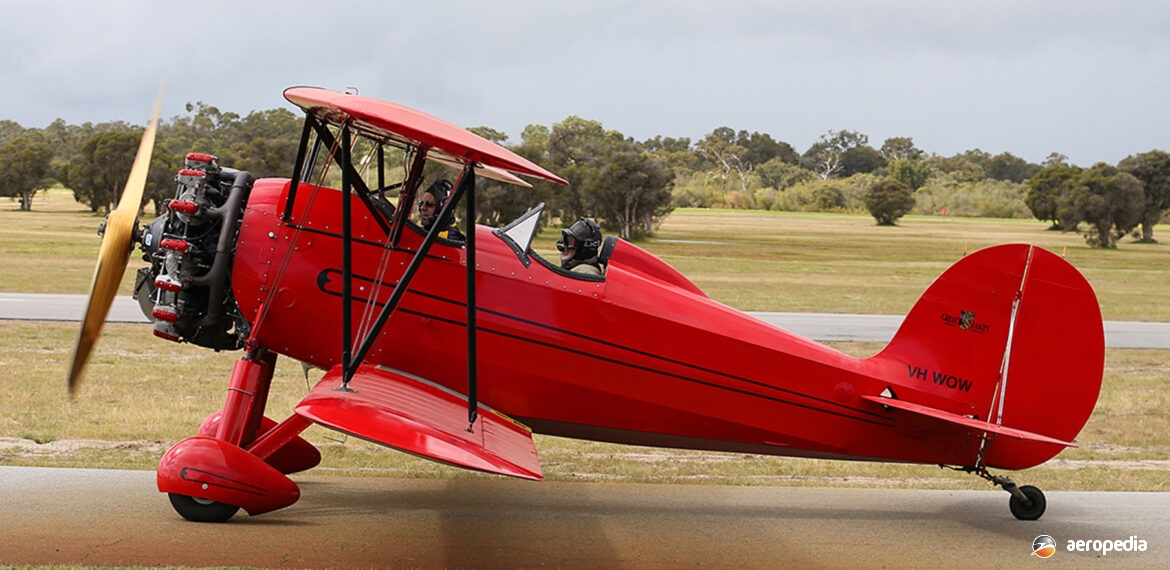Photograph:
Great Lakes 2T-1A-2 Sport Trainer VH-WOW at Serpentine, WA in November 2014 (Keith Anderson – Aviation WA)
Country of origin:
United States of America
Description:
Two-seat light touring and training biplane
Power Plant:
One 67 kw (90 hp) American Cirrus Engine Mark 3 four-cylinder in-line air-cooled engine
Specifications:
- Wingspan upper and lower: 8.16 m (26 ft 8 in)
- Length: 6.19 m (20 ft 4 in)
- Height: 2.42 m (7 ft 11 in)
- Wing area [upper]: 9.01 m² (97 sq ft)
- Wing area [lower]: 8.41 m² (90.6 sq ft)
- Wing area [total]: 17.42 m² (187.6 sq ft)
- Wing chord: 1.168 m (46 in)
- Max speed: 185 km/h (115 mph)
- Cruising speed: 156 km/h (97 mph)
- Landing speed: 72 km/h (45 mph)
- Initial rate of climb at sea level: 238 m/min (780 ft/min)
- Climb to 1,524 m (5,000 ft): 8 mins
- Ceiling: 3,810 m (12,500 ft)
- Range: 603 km (375 miles)
- Empty weight: 500 kg (1,102 lb)
- Useful load: 262 kg (578 lb)
- Loaded weight: 717 kg (1,580 lb)
History:
The Great Lakes Aircraft Corporation was formed in 1928 in Cleveland, Ohio, to produce sport aircraft for the United States market, and introduced the 2-T-1 in 1929. The swept-wing biplane was one of the success stories of light biplane production of the 1930s, becoming known for its performance on the low power available. A straight-wing model was also produced but only four examples were completed.
After its introduction to the American public at the Detroit Air Show in March 1929 orders began to flow in. Soon the Great Lakes ‘Sport’ became popular and the Company’s production lines had great difficulty in meeting demand. By mid 1929 the Company had 750 employees, and had outstanding orders for 700 aircraft. However, the stock market crash of 1929, and the Great Depression, greatly affected the sales of light aircraft, which caused hundreds of orders to be cancelled and production soon slowed. Regardless, some hundreds were built by the Company at its facility at Cleveland.
The 2-T-1 was found to be robust and was used for a number of long distance flights, including a non-stop flight from Canada to the United States and into Mexico in August 1929, a distance of 2,173 km (1,350 miles) at 166 km/h (103 mph) when flown by Tex Rankin. Later he established a world record of 19 consecutive outside loops.
Production continued slowly, the next model being the 2-T-1E with the Cirrus engine inverted. The fuselage framework was built up of welded chrome molybdenum steel tubing, faired to shape with metal formers and metal fairing strips, with fabric covering. The wing framework was of solid spruce spar beams routed to an I-beam section and the wing ribs were stamped out from duralumin sheet, the leading-edges being metal covered and the remainder fabric covered.
Development of the type continued for a number of years, and examples were fitted with skis and twin-floats. A winter canopy enclosure could also be installed over the cockpit.
The 2-T-1 had the Cirrus Mk 3, which was a four-cylinder air-cooled engine of British design manufactured in the United States by American Cirrus Engines (ACE) and was rated at 63 kw (85 hp) at 1,900 rpm and 71 kw (95 hp) at 2,100 rpm. The 2-T-1A had the 67 kw (90 hp) American Cirrus unit, built under licence by American Cirrus Engines. This engine was manufactured in the United States by GLAC and was a refinement of the United Kingdom-built Cirrus Mk 3. Development of the aircraft over the years produced some minor changes to improve comfort and handling, and some were fitted with low-pressure tyres.
In later years many survivors were re-engined with power plants supplying up to 149 kw (200 hp), and these included Warner and Kinner radials, and a variety of Menasco units.
In 1930 the sport-trainer 1-T-1E model appeared with a swept wing but was otherwise similar to the earlier models, this variant having the Cirrus engine inverted.
In 1972 a company, Windward Aviation of Enid, Oklahoma placed the Model 2-T-1A back into production in two models, the 2-T-1A-1 with a 112 kw (150h p) Lycoming engine, and the 2-T-1A-2 with a 134 kw (180 hp) Lycoming engine.
One proposed variant was the 2-T-1T, a prototype of which was built with an Allison 250 turboprop, but this was lost during testing and no more were built. A number of model designations were applied and, because of its popularity, a number have been restored in the United States and the United Kingdom, models surviving including the 2-T-1MS and 2-T-1R Speedster.
In 2004 an example of the 2-T-1A-2 was imported to Melbourne, VIC, becoming VH-LKE (c/n 0705 – ex N74GL) on 11 June 2004, this being the fifth production aircraft of this model, the major components of which were built at Wichita, Kansas, final assembly taking place in Oklahoma.
A 2-T-1A-2 Sports Trainer fitted with a Lycoming IO-360 engine became VH-WQW (c/n 003 – ex N264SA) in late 2008; and in April 2016 a 2-T-A1 became VH-UYB (c/n SN2013GL) to its owner at Gatton, QLD.
An example was imported to New Zealand in 2006. This aircraft (ex N308Y) has been restored and has been powered by a Warner Super Scarab engine. On 11 April 2012 another example became ZK-ULM (c/n BLUL-01) to Mr B Parkinson of Rangiora.

